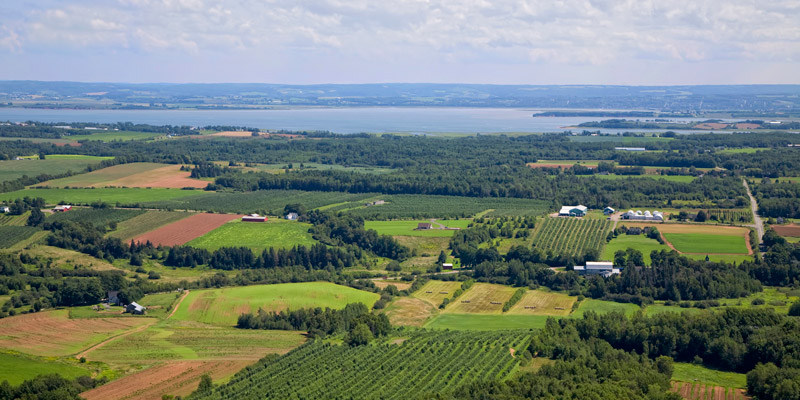Non-point Sources of Pollution, Cumulative Effects and Mitigation in Urban/Rural Fringe Watersheds in the Lower Fraser Valley, B.C
Principal Investigators - Hans Schreier and Ken Hall, University of British Columbia (2001-2004)

Challenge
The Lower Fraser Valley in British Columbia has undergone rapid urbanization over the last ten years, while an established Agricultural Land Reserve (ALR) has supported the growth and intensification of farming and livestock operations. Due to good transportation infrastructure and large local and export market potential, the area now has the highest livestock density in Canada. Intensified agriculture has resulted in excessive nutrients being applied to a shrinking land base. These nutrients have caused widespread eutrophication problems, adversely effecting groundwater resources that provide drinking water to 25% of the population. Urban expansion is taking place on steeply sloping mountain terrain, which may worsen storm water runoff and flooding in the lowlands.
The aims of the project were to evaluate the effect of non-point sources of pollution from urban and agricultural sources, to develop new methods to examine cumulative effects on watersheds with a focus on trace metals, pathogens, and antibiotics, and to test innovative methods to reduce ecosystem and human health impacts.
The results of this research have benefitted farmers, municipalities and regulatory agencies in relation to municipal storm water management techniques, and to track pathogens and antibiotics in the environment, as well as implement methods for integrated storm water management and integrated catchment evaluation.
Project
The research included urban land use impacts on water, using street surface, stream and lake sediments data collected over a 25-year period (1973, 1993, 1997-1998). These samples were analyzed for total and acid extractable trace metals. They found that traffic and pervious areas are correlated with metals which tend to accumulate in sediments. Source control (removing lead from gasoline) is improving environmental conditions, and collecting storm water runoff in detention ponds and wetlands before they are discharged into streams is partially effective in improving aquatic systems. The research showed that vegetation in detention ponds can be effective in retaining metals and therefore significantly reduce the impact of urban runoff on local streams.
Researchers also looked at the effect of excess agricultural nutrients on groundwater and streams. Using the Agricultural Census data the Lower Fraser Valley was divided into 20 communities and a very detailed nutrient budget was determined for all agricultural areas. This collaborative study with Environment Canada showed that the average annual surplus application of Nitrogen exceeded 100 kg/ha/y and the average Phosphorus applications exceeded 50 kg/ha per year. These excess nutrient applications were through septic system density or nutrient surplus applications to the land.
The third research area included the development of innovative methods to monitor metal, pathogens and antibiotics in watersheds. The sample area contained the highest livestock density in the country, and the studies showed that the nitrate levels have increased exponentially over the past 35 years in the river and similarly Zinc (used as a feed additive) in sediment has shown a significant increase in the past 10 years.
Outputs
- Development of a new technique using Diffusive Gradient in Thin Film (DGT) to monitor bio-available metals over time and to determine the accumulation of bio-available metals during different storm events. They were able to measure bacterial, organic and sediment concentrations with absorption, reflection and fluorescence, and developed techniques to track antibiotic residues and tetracycline resistant genes in agricultural watersheds.
- Documentation of the extent of non-point source pollution from agricultural sources in the form of annual nutrient budgets at a regional scale, and in 3 aquifers for which little previous information was available.
- The researchers worked with farmers, municipalities and regulatory agencies to distribute the results in novel ways (workshops, CD-ROMs) and to suggest what the best management practices are to mitigate nutrient loading, storm water management and contamination problems. They also presented their findings through publications in national and international journals, and conference proceedings.
Select Presentations
Li, K.W., Kilgour, D.M., and Hipel, K.W., “Status Quo Analysis in Conflict Resolution”, presented at Group Decision and Negotiation 2002, held at Curtin University, Perth, Australia, August 26-29, 2002.
Hamouda, L., Hipel, K.W., and Kilgour, D.M., “Strength of Preference in Conflict Resolution”, presented at Group Decision and Negotiation 2002, held at Curtin University, Perth, Australia, August 26-29, 2002.
Kilgour, D.M. and Hipel, K.W., “Demonstration of the Decision Support System GMCR II”, presented at Group Decision and Negotiation 2002, held at Curtin University, Perth, Australia, August 26-29, 2002.
Hipel, K.W., keynote presentation on “Decision Support Systems in Water Resources Management,” delivered at the Third International Conference on Water Resources and Environment Research: Water Quantity and Quality Aspects in Modeling and Management of Ecosystems, ICWRER 2002, held at the Dresden University of Technology, Dresden, Germany, July 22-25, 2002.
Kilgour, D.M., plenary presentation on “Intergovernmental Decision Making – A Strategic Approach Using GMCR II,” delivered at the Workshop on Resolving Conflicts – Acknowledging a Scientific Approach, held at Zentrum für interdisziplinäre Forschung (Centre for Interdisciplinary Research), Universitat Bielefeld, Bielefeld, Germany, June 2002.
Noakes, D.J., Fang, L., Hipel, K.W., and Kilgour, D.M., “Conflict Resolution in Resource Management,” presented at the 44th Annual Conference of the Canadian Operational Research Society (CORS), held at the Colony Hotel, Toronto, Ontario, June 3-5, 2002.
Zhang, J., Fang, L., and Hipel, K.W., “Walkerton Drinking Water Crisis: Modeling and Analysis,” presented at the 44th Annual Conference of the Canadian Operational Research Society (CORS), held at the Colony Hotel, Toronto, Ontario, June 3-5, 2002.
Select Publications
Hipel, K.W., Kilgour, D.M., and Zhao, N.Z. (2003). “Risk Analysis of the Walkerton Drinking Water Crisis”, Canadian Water Resources Journal, Vol. 28, Sept., 2003.
Noakes, D. J., Fang, L., Hipel, K. W., and Kilgour, D.M. (2003). “An Examination of the Salmon Aquaculture Conflict in British Columbia using the Graph Model for Conflict Resolution”, Fisheries Management and Ecology, Vol. 10, No.3, pp.123-137.
Obeidi, A., Hipel, K.W., and Kilgour, D.M. (2002). “Canadian Bulk Water Exports: Analyzing the Sun Belt Conflict using the Graph Model for Conflict Resolution”, Knowledge, Technology and Policy, Vol. 14, No. 4, pp. 145 – 163.
Hipel, K.W., Kilgour, D.M., Fang, L., and Li, K.W. (2002). “Resolution of Water Conflicts between Canada and the United States”, invited paper published as Section 4.3 in State of the Art Report on Systems Analysis Methods for Resolution of Conflicts in Water Resources Management, edited by K.D.W. Nandalal and S.P. Simononvic, a Report prepared for the Division of Water Sciences, United Nations Educational, Science and Cultural Organization (UNESCO), Paris, France.
Outcomes
- The results of this research will aid municipalities and regulatory agencies to apply storm water management techniques, to track pathogens and antibiotics in the environment, as well as implement methods for integrated storm water management and integrated catchment evaluation.
- Changes in practice as cities such as Chilliwack and Langley have adopted the practice of storm water detention ponds.
- Researchers with this project were able to network with the B.C. Centre for Disease Control to facilitate future collaboration on source tracking of pathogens. Work with other research partners was also productive, as they developed a relationship to conduct research with a private enterprise (Joule Microsystems Inc.), and worked with Health Canada in the development of analytical techniques to measure antibiotics in the environment.




